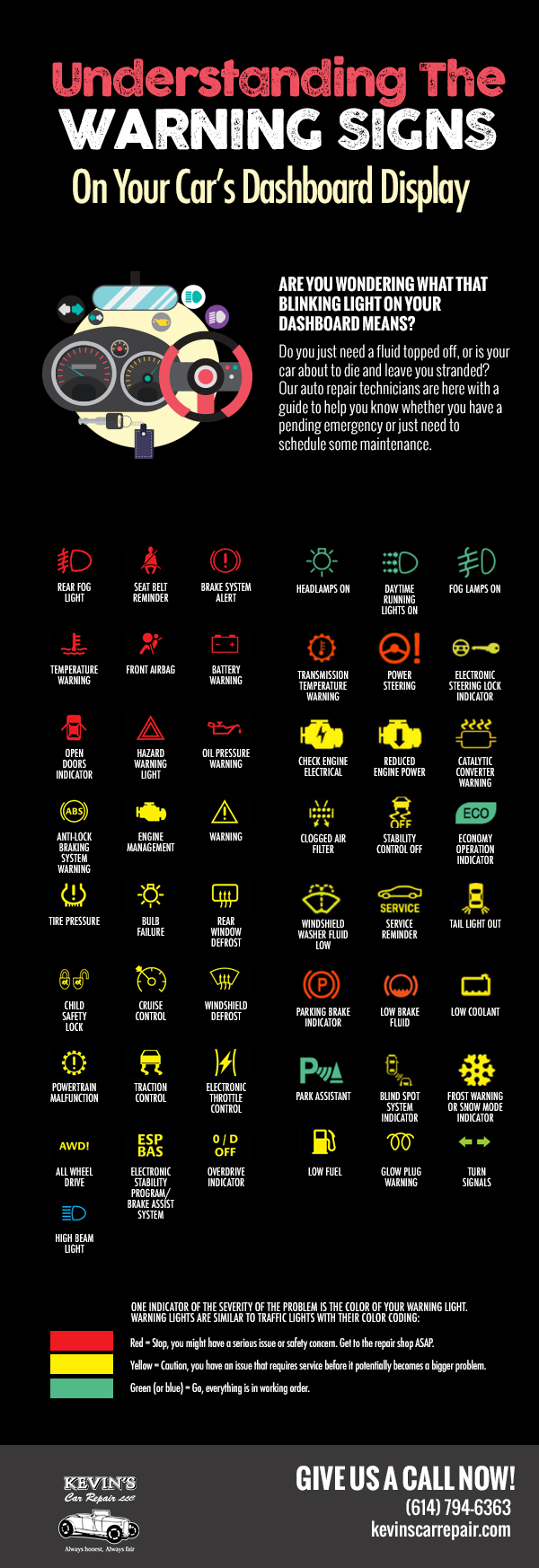Examining Your Car'S Warning Indicators: What They Really Communicate
Examining Your Car'S Warning Indicators: What They Really Communicate
Blog Article
Content By-Sykes Gilbert
When you're behind the wheel, those beautiful caution lights on your control panel can be a little bit puzzling. Do you recognize what they're trying to inform you regarding your cars and truck's health? Understanding the relevance of these lights is important for your security and the long life of your automobile. So, https://brakes-and-rotors51738.dailyhitblog.com/36670479/expecting-the-future-of-vehicle-repair-work-significant-trends-to-watch-on among those lights pops up, wouldn't you want to analyze its message accurately and take the needed actions to address it?
Common Warning Lights and Interpretations
Recognize common caution lights in your auto and comprehend their significances to ensure safe driving.
One of the most common caution lights include the check engine light, which signifies problems with the engine or discharges system. If this light comes on, it's critical to have your automobile inspected quickly.
The oil pressure cautioning light suggests low oil stress, needing instant focus to stop engine damages.
A flashing battery light might suggest a defective billing system, potentially leaving you stranded if not resolved.
The tire stress tracking system (TPMS) light signals you to low tire stress, influencing car stability and fuel effectiveness. Overlooking this can bring about dangerous driving problems.
The ABS light suggests a trouble with the anti-lock stopping system, jeopardizing your ability to quit swiftly in emergencies.
Lastly, the coolant temperature level advising light warns of engine overheating, which can lead to severe damages otherwise fixed promptly.
Comprehending these common caution lights will certainly aid you resolve issues quickly and keep risk-free driving problems.
Importance of Prompt Attention
Understanding the common warning lights in your auto is only the first step; the relevance of immediately resolving these cautions can not be highlighted sufficient to guarantee your safety when driving.
When a warning light illuminates on your dashboard, it's your cars and truck's way of interacting a potential concern that needs interest. Overlooking these cautions can lead to extra severe problems in the future, endangering your security and possibly costing you much more in repairs.
Prompt attention to cautioning lights can stop malfunctions and accidents. For example, a blinking check engine light might suggest a misfire that, if left ignored, can cause damages to the catalytic converter. Addressing this immediately can save you from a costly repair service.
Likewise, a brake system alerting light might signal reduced brake fluid or worn brake pads, important elements for your security when driving.
DIY Troubleshooting Tips
If you discover a caution light on your control panel, there are a few DIY fixing suggestions you can attempt before looking for expert help.
The first step is to consult your auto's guidebook to comprehend what the details warning light shows. Sometimes the concern can be as easy as a loose gas cap setting off the check engine light. Tightening the gas cap might fix the trouble.
An additional common issue is a reduced battery, which can set off numerous advising lights. Checking https://www.thedrive.com/maintenance-repair/40307/how-to-build-the-perfect-garage for deterioration and ensuring they're protected may fix the trouble.
If a warning light persists, you can attempt resetting it by separating the automobile's battery for a few minutes and afterwards reconnecting it. Furthermore, examining your vehicle's liquid levels, such as oil, coolant, and brake fluid, can aid fix alerting lights associated with these systems.
Conclusion
Finally, recognizing your cars and truck's caution lights is crucial for maintaining your car running smoothly and safely. By immediately addressing these informs and understanding what they mean, you can prevent expensive repair work and potential failures.
Bear in mind to consult your automobile's handbook for particular information on each cautioning light and do something about it as necessary to ensure a hassle-free driving experience.
Stay educated, remain secure on the road!
